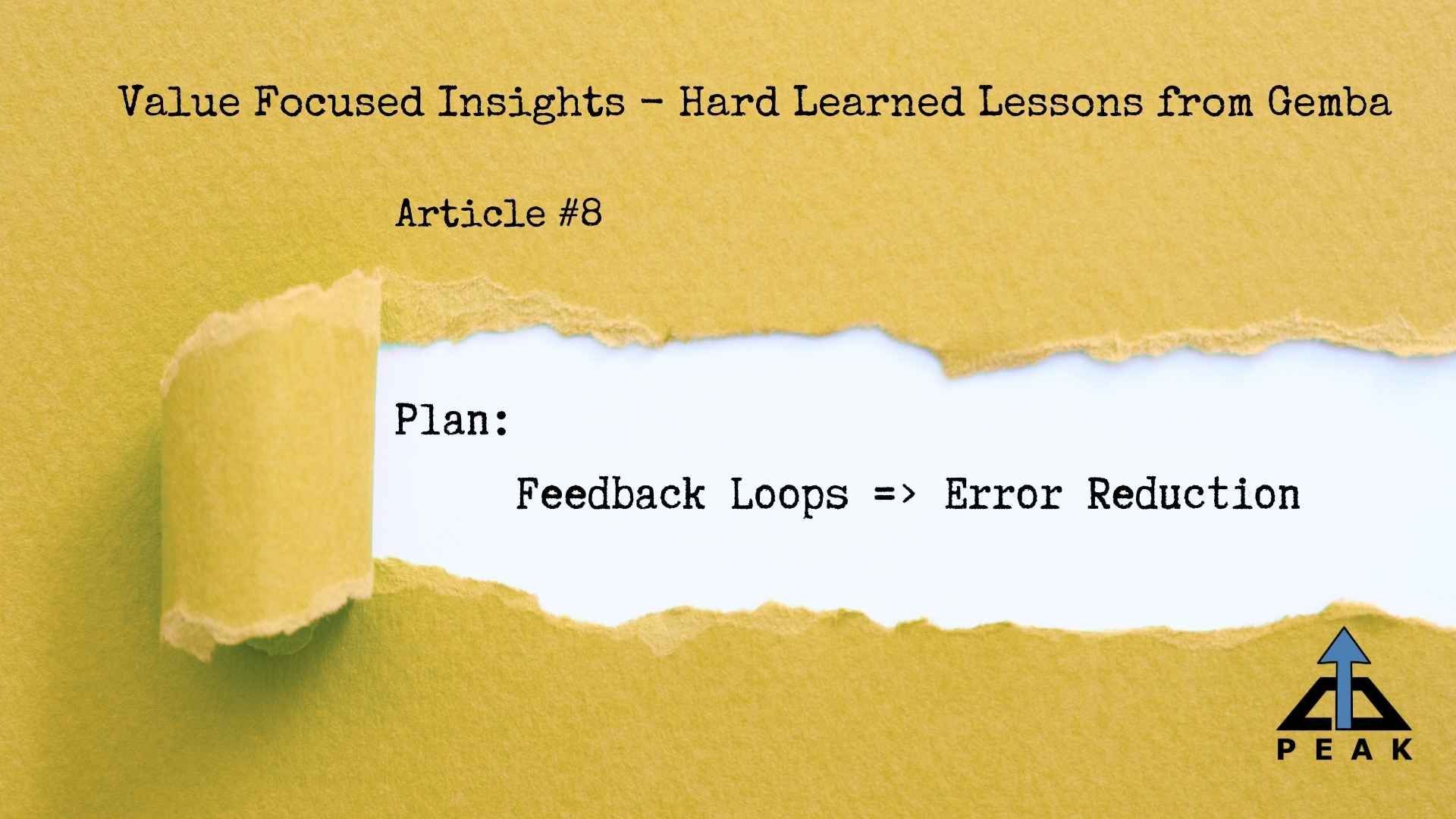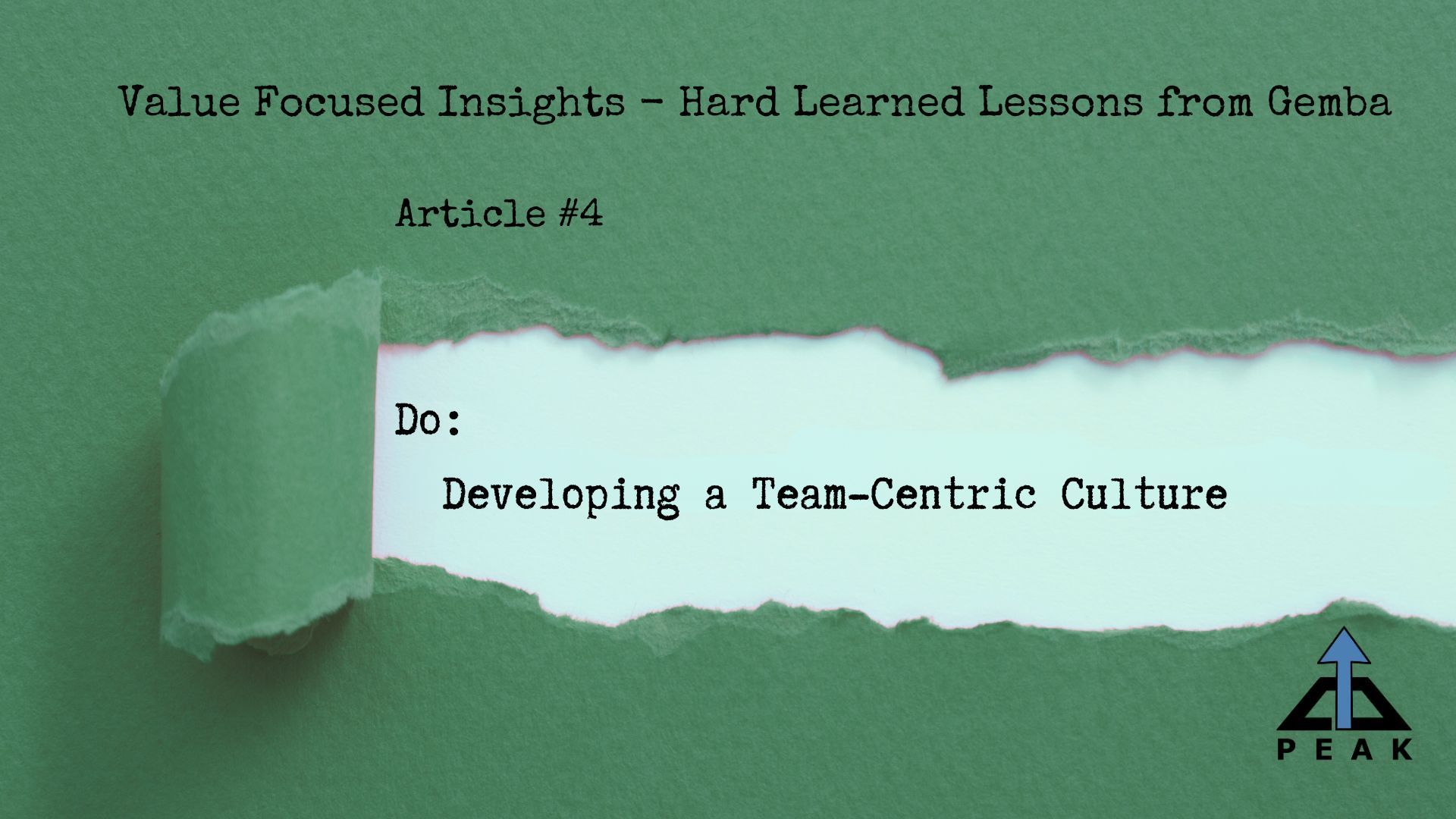Embracing Slower Times - Part 1: Building Resilience for Long-Term Success
Tim Upchurch
There will be periods of slower demand. You may be experiencing one now.
How your organization responds will determine how quickly you recover when demand returns and whether you gain or lose additional market share as a result.
Over the next quarter, Peak Productivity will be presenting a series of articles how to take advantage of slower times to build resilience for long term success.
In this first article of the series, we review the standard playbook many organizations use in response to slower demand and why it is not an effective strategy. We provide an alternative perspective to consider that leads us into future articles.

Organizations will occasionally encounter periods of slowdown in demand. Whether triggered by external factors, market fluctuations, or seasonal variations, these periods can pose challenges for businesses and create stress for employees. The knee-jerk reaction for many is to immediately downsize or assign people to non-value-added activities.
However, it doesn't have to be that way. I advocate for a proactive approach where you "embrace the suck" – to consciously accept or appreciate something that is extremely unpleasant but unavoidable for forward progression. The best businesses are those that quickly adapt and thrive in times of change. Learning to use periods of lower demand to make your business more resilient will better prepare you for the eventual return of demand.
Over the next quarter, Peak Productivity will present a series of articles on how to achieve this. Join us as we provide an alternative approach to traditional business countermeasures during challenging times. We will offer a framework of solutions designed to improve all aspects of your operations based on our proprietary business improvement approach: process stability, engaged teams, action-biased execution, and key solutions. These are based on our past experiences, so your team can take advantage of the lessons we’ve accumulated throughout our careers.
In the normal business cycle, companies will struggle to consistently meet demand due to various common business problems. In response, some customers will place more orders than necessary, creating artificial urgency and leading you to build more capacity than needed. When demand eventually slows, all that excess inventory built up in the supply chain escalates a bad problem into an emergency - rapidly decreasing or cancelled orders.
Many of us have experienced a sudden loss in demand. Layoffs are often the immediate response to stop the bleeding of cash. The impact is primarily felt by the people who create value, whether they are production operators in manufacturing or frontline workers in service businesses. The logic behind this approach is to balance labor costs with the projected level of demand for the foreseeable future. While it may seem sensible to immediately cut expenses such as excess labor, overtime, major repairs, and delay capital expansions, this short-term strategy can cost your business many times in the long run what you might save. It can also alienate your customers because you will inevitably struggle to meet the new lower levels of demand for several key reasons.
Reason 1 – Absenteeism: As a rule of thumb, if you are staffed exactly to meet your projected level of demand and productivity, you will need about 15%-20% overtime to just account for absenteeism. This figure applies to each specialized or certified role in your processes. If you fail to allow for the excess cost of overtime during slower periods, any significant time missed by employees will prevent you from meeting demand. If production flow is not steady, you may require even more overtime to counter. Your team knows when the workload is typically heavy and frequently plans their time off accordingly.
Reason 2 - Backfilling: Most organizations have some level of division of labor within their ranks. Different positions, roles, and skill levels are necessary to fulfill the total value and waste in your current process. Unfortunately, layoffs affecting workers are often determined by seniority or other factors that do not consider the workload of production or service. After every round of layoffs, gaps appear in the value stream, requiring workers to be moved from their current positions and retrained to meet new job requirements. Depending on the industry and roles involved, extensive training or certifications may be necessary, adding to delays. During the transition, new workers will not be capable of producing at the standard rate because they are not yet fully productive. If you use the current personnel who were not displaced to train these new employees, you will experience a double hit to production. They cannot train and maintain the standard rate simultaneously.
Quality and safety can be dramatically impacted during these transitional periods. Everyone needs time to adjust to new surroundings and processes. Newer employees pose greater safety risks and are more prone to making mistakes. Depending on the influence each person has on the overall quality of your product or service, the costs of quality lapses could be catastrophic. Without well-defined standard work, excellent quality checks, and detailed process understanding, personnel changes during slow periods will result in reduced safety and quality. The last thing you need during this time is cancelled orders due to poor quality or high costs of dealing with returned products.
Reason 3 – Fear: Human beings are not all the same. Some are more resilient than others. During periods of layoffs, previous trust built between management and the workforce will erode. The longer the pain lasts, the longer the impact on team morale. During this time, some people will be distracted and not focused on their work; they will be thinking from a position of fear. This impact on productivity is evident as people gather to discuss the latest rumors and more.
Safety and quality remain the biggest concerns. While many workplaces have become extremely safe over time, they can still be inherently dangerous if individuals are not fully “present” and paying attention to their surroundings. Quality escapes are always costly, but during times of lower demand, customers may turn minor quality issues into reasons for canceling or returning orders they no longer immediately need. As mentioned earlier, less experienced personnel make more errors, so any quality lapses during slow periods can quickly impact financials. You cannot allow any countermeasure to demand negatively impact hard earned quality and safety levels.
Assigning people "busy work" deserves a quick comment. If the roles were reversed and your company was going through layoffs, how would you feel if your boss assigned you to meaningless tasks? If you assign someone to a different task than usual, make sure you explain the business relevance and context so they don't fill in any gaps that might make them afraid or paranoid.
Reason 4 – Noise: In “The Goal”, Goldratt provided us with the mathematical reasoning why you can’t achieve demand with balanced capacity in a complex system. It’s due to two major reasons: dependent events and statistical fluctuations. He goes on to say,
“…when capacity is trimmed exactly to marketing demands, no more and no less, throughput goes down, while inventory goes through the roof”.
You will fail – not because your team is poor, but because your hypothesis is flawed.
Unfortunately, most organizations don't have a single round of layoffs but go through several rounds in response to rapidly changing market conditions. Each round of layoffs is followed by periods of lower productivity as management works to rebalance capabilities to meet the new demand. Value-producing workers are stretched further in each, making it harder to stabilize after every successive round of layoffs. Until the dust settles and everyone necessary to consistently achieve the final lower level of demand is in place, fully trained and capable of meeting productivity and quality requirements, your production output and ability to satisfy customers will struggle. This means you will likely fail to achieve your new lower production or service levels and may even risk losing additional market share.
I've experienced several of these cycles throughout my career. At some point, the tide changes, and orders ramp back up. Normally, the transition is just as violent going up as the slowdown was, and customer demand returns rapidly. Cost now takes a back seat to volume – delivery becomes the priority. If you have followed the cost reduction playbook for slower demand, you will now need to retool, rehire, retrain, refill your supply chain, and rebuild trust with your team. The bad news is that there is little chance that you will be able to meet normal recovery demand levels for those very reasons.
Retooling – You might have shut down equipment and even cannibalized parts from it to keep other machines running and save money. The ramp-up process will take time and may require requalification. Quality and productivity will be impacted during this period.
Rehiring/Retraining – Rehiring everyone immediately is unrealistic. Not everyone you want will come back, and you will need to consider new candidates. This means conducting interviews, testing, background checks, and other onboarding requirements. The initial plan will be needed in weeks but will take quarters to complete for a variety of reasons – this is not an HR issue, it’s a market and systems issue. Additionally, when new hires are finally in the building, who will train them while demand exceeds your current capacity?
Refilling Your Supply Chains – When your organization didn't reorder, your suppliers may have stopped producing materials. They may have found other customers or even gone out of business. Rebuilding your supply chain and replenishing your inventory pipeline to support higher demand will take time. Lead times will expand as suppliers ramp up, resulting in delays and interruptions to normal flow until all systems are stable again.
Rebuilding Trust – Forgiveness doesn't come quickly. Restoring trust requires doing the right thing consistently over several years. Don't expect the previous levels of commitment from people to return with demand.
Eventually, your organization will start to rebound and begin to back-fill levels of management that were removed. People that survived will be promoted, and new managers will take their place. As a result of the above conditions, the new team inevitably starts to miss delivery requirements. Customers may again place additional orders into the system. The new team will react and build additional capacity to meet that inflated target. The cycle starts again…
- Do you want to repeat the cycle or break it and evolve?
- Do you want to get ahead of the cycle instead of always being behind it?
- Do you want to stop reacting and become proactive?
What if we approached these slower times with a different mindset? What if we saw them as opportunities for long-term improvement? At Peak Productivity, we believe that embracing slower times with an improvement mindset can be the catalyst for transformative change and continuous growth. Let's explore the idea of utilizing downturns to focus on improving both our people and processes, rather than wasting precious resources on unproductive endeavors with limited short-term results.
Opportunity 1 - Shifting the Perspective: During a slowdown, the natural inclination is to immediately cut costs to survive. However, as mentioned earlier, such short-term measures make us more vulnerable and have long-lasting negative consequences. Instead, view these periods as investments in the future. Shift from being a "fragile" and reactive business to becoming "anti-fragile" and proactive. The goal is to make the business more efficient and resilient to thrive in any cycle. To achieve this, we must change our perspective from a cost-centric to a value-centric mindset. Improved efficiencies will allow you to meet changes in capacity with lower cost and fewer required resources and to break free from the current wild swings in staffing.
Peak Perspective:
- VALUE is always king.
- Build resilience for all business environments.
- Continuously strive to improve your VALUE/COST ratio.
- If demand is high, focus more on delivering value.
- If demand is low, focus more on harvesting value.
Following articles in this series will go into more detail on shifting the perspective and showcase other opportunities to embrace when demand is slow.
Embracing slower times to build resilience for long-term success is a strategic approach that can yield significant benefits for organizations. Instead of only resorting to short-term cost-cutting measures or idle activities, we suggest you redirect your focus towards investing in people and optimizing processes. Change your perspective to build stability and resilience in your organization. By engaging employees, reinforcing lean principles, and creating a roadmap for improvement, you lay the foundation for enhanced productivity, cost efficiency, and sustainable growth. By doing this, you can break away from large swings in staffing to consistently achieve customer demand with lower costs and resources for all phases of the business cycle. Any upfront costs you spend will pay huge dividends going forward.
At Peak Productivity, we understand the challenges that shifts in demand will bring. Our consulting services can provide guidance and support to help your organization navigate through slower times and emerge stronger than ever. Together, let's seize the opportunity to transform challenges into opportunities for long-term success.
Please be sure to visit our website at www.peakproconsulting.com or follow us on our LinkedIn page to receive updates on all future articles in this series. The body content of your post goes here. To edit this text, click on it and delete this default text and start typing your own or paste your own from a different source.
Peaks and Valleys.....












